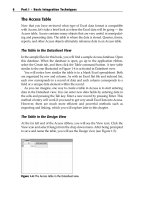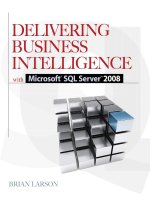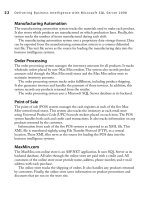Business analysis with microsoft excel and power BI
Bạn đang xem bản rút gọn của tài liệu. Xem và tải ngay bản đầy đủ của tài liệu tại đây (30.66 MB, 744 trang )
About This E-Book
EPUB is an open, industry-standard format for e-books. However, support for EPUB and its
many features varies across reading devices and applications. Use your device or app settings
to customize the presentation to your liking. Settings that you can customize often include font,
font size, single or double column, landscape or portrait mode, and figures that you can click or
tap to enlarge. For additional information about the settings and features on your reading device
or app, visit the device manufacturer’s Web site.
Many titles include programming code or configuration examples. To optimize the
presentation of these elements, view the e-book in single-column, landscape mode and adjust
the font size to the smallest setting. In addition to presenting code and configurations in the
reflowable text format, we have included images of the code that mimic the presentation found
in the print book; therefore, where the reflowable format may compromise the presentation of
the code listing, you will see a “Click here to view code image” link. Click the link to view the
print-fidelity code image. To return to the previous page viewed, click the Back button on your
device or app.
Business Analysis with Microsoft Excel
Conrad G. Carlberg
Business Analysis with Microsoft Excel
Copyright © 2019 by Pearson Education, Inc.
All rights reserved. This publication is protected by copyright, and permission must be obtained
from the publisher prior to any prohibited reproduction, storage in a retrieval system, or
transmission in any form or by any means, electronic, mechanical, photocopying, recording, or
likewise. For information regarding permissions, request forms, and the appropriate contacts
within the Pearson Education Global Rights & Permissions Department, please visit
www.pearsoned.com/permissions/. No patent liability is assumed with respect to the use of the
information contained herein. Although every precaution has been taken in the preparation of
this book, the publisher and author assume no responsibility for errors or omissions. Nor is any
liability assumed for damages resulting from the use of the information contained herein.
ISBN-13: 978-0-7897-5958-0
ISBN-10: 0-7897-5958-6
Library of Congress Control Number: 2018960904
01 18
Trademarks
All terms mentioned in this book that are known to be trademarks or service marks have been
appropriately capitalized. Que Publishing cannot attest to the accuracy of this information. Use
of a term in this book should not be regarded as affecting the validity of any trademark or
service mark.
Warning and Disclaimer
Every effort has been made to make this book as complete and as accurate as possible, but no
warranty or fitness is implied. The information provided is on an “as is” basis. The author and
the publisher shall have neither liability nor responsibility to any person or entity with respect
to any loss or damages arising from the information contained in this book.
Special Sales
For information about buying this title in bulk quantities, or for special sales opportunities
(which may include electronic versions; custom cover designs; and content particular to your
business, training goals, marketing focus, or branding interests), please contact our corporate
sales department at or (800) 382-3419.
For government sales inquiries, please contact
For questions about sales outside the U.S., please contact
Editor-in-Chief
Brett Bartow
Acquisitions Editor
Trina MacDonald
Development Editor
Charlotte Kughen
Managing Editor
Sandra Schroeder
Senior Project Editor
Tonya Simpson
Indexer
Erika Millen
Proofreader
Lori Eby
Technical Editors
John Hagens
Errin O’Connor
Editorial Assistant
Cindy Teeters
Cover Designer
Chuti Prasertsith
Compositor
codemantra
Contents at a Glance
1 Working with Income Statements
2 Balance Sheet: Current Assets
3 Valuing Inventories for the Balance Sheet
4 Summarizing Transactions: From the Journals to the Balance Sheet
5 Working Capital and Cash Flow Analysis
6 Statement Analysis
7 Ratio Analysis
8 Budgeting and Planning Cycle
9 Forecasting and Projections
10 Measuring Quality
11 Examining a Business Case: Investment
12 Examining Decision Criteria for a Business Case
13 Creating a Sensitivity Analysis for a Business Case
14 Planning Profits
15 Making Investment Decisions Under Uncertain Conditions
16 Fixed Assets
17 Importing Business Data into Excel
18 Exporting Business Data from Excel
19 Using Excel 2016 and Power BI to Analyze QuickBooks Data
20 Analyzing Contributions and Margins
21 Pricing and Costing
Index
Contents
1 Working with Income Statements
Keeping Score
Choosing the Right Perspective
Defining Two Purposes for Accounting
Using the Income Statement
Choosing a Reporting Method
Cells in Excel
Measuring the Operating and Nonoperating Segments
Moving from the General Journal to the Income Statement
Getting the General Journal into Excel
Understanding Absolute, Relative, and Mixed References
Getting the Journal Data to the Ledger
Getting the Ledger Data to the Income Statement
Managing the Financial Analyses with Accrual Accounting
Using Straight-Line Depreciation
Preparing the Trial Balance
Moving Information into an Income Statement
Organizing with Traditional Versus Contribution Approaches
About Power BI
Power BI Desktop
Power BI Service and Mobile Apps
Summary
2 Balance Sheet: Current Assets
Designing the Balance Sheet
Understanding Balance Sheet Accounts
Understanding Debit and Credit Entries
Getting a Current Asset Cash Balance
Using Sheet-Level Names
Getting a Cash Balance for Multiple Cash Accounts
Handling Restricted Cash Accounts
Getting a Current Asset Accounts Receivable Balance
Allowing for Doubtful Accounts
Using the Aging Approach to Estimating Uncollectibles
Using the Percentage of Sales Approach to Estimating Uncollectibles
Displaying Doubtful Account Balances with Power BI
Managing the Sort Order Via the Axis Values
Managing the Sort Order with Another Field
Getting a Prepaid Expenses Balance
Dealing with Insurance as a Prepaid Expense
Getting a Current Asset Balance
Understanding the Inventory Flow
Closing the Inventory Account
Closing the Revenue and Expense Accounts
Summary
3 Valuing Inventories for the Balance Sheet
Understanding Perpetual and Periodic Inventory Systems
Perpetual Inventory Systems
Periodic Inventory Systems
Valuing Inventories
Valuation Methods Summarized
Using Specific Identification
Using Average Cost
Using the Moving Average Method
Using FIFO
Using LIFO
Comparing the Four Valuation Methods
Specification Identification
Average Cost
FIFO
LIFO
Handling Purchase Discounts
Calculating Turns Ratios
Summary
4 Summarizing Transactions: From the Journals to the Balance Sheet
Understanding Journals
Understanding Special Journals
Structuring the Special Sales Journal
Structuring the Special Purchases Journal
Structuring the Cash Receipts Journal
Structuring the Cash Payments Journal
Excel Tables and Dynamic Range Names
Building Dynamic Range Names
Using Dynamic Range Names in the Journals
Choosing Between Tables and Dynamic Range Names
Understanding Ledgers
Creating the General Ledger
Using Subsidiary Ledgers
Automating the Posting Process
Getting a Current Liabilities Balance
Summary
5 Working Capital and Cash Flow Analysis
Matching Costs and Revenues
Broadening the Definition: Cash Versus Working Capital
Determining the Amount of Working Capital
Determining Changes in Working Capital
Analyzing Cash Flow
Developing the Basic Information
Summarizing the Sources and Uses of Working Capital
Identifying Cash Flows Due to Operating Activities
Combining Cash from Operations with Cash from Nonoperating Transactions
Summary
6 Statement Analysis
Understanding a Report by Means of Common-Sizing
Using Common-Sized Income Statements
Using Common-Sized Balance Sheets
Using Comparative Financial Statements
Using Dollar and Percent Changes in Statement Analysis
Assessing the Financial Statements
Handling Error Values
Evaluating Percentage Changes
Common-Sizing for Variance Analysis
Common-Sizing by Headcount
Showing Common-Sized Statements with Power BI
Summary
7 Ratio Analysis
Interpreting Industry Averages and Trends
Comparing Ratios Within Industries
Analyzing Ratios Vertically and Horizontally
Getting a Basis for Ratios
Analyzing Profitability Ratios
Finding and Evaluating Earnings Per Share
Determining Gross Profit Margin
Determining Net Profit Margin
Determining the Return on Assets
Determining the Return on Equity
Analyzing Leverage Ratios
Determining the Debt Ratio
Determining the Equity Ratio
Determining the Times Interest Earned Ratio
Analyzing Liquidity Ratios
Determining the Current Ratio
Determining the Quick Ratio
Analyzing Activity Ratios
Determining the Average Collection Period
Determining Inventory Turnover
Displaying Financial Ratios in Power BI Reports
Summary
8 Budgeting and Planning Cycle
Creating Pro Forma Financial Statements
Forecasting by Percentage of Sales
Using Excel to Manage the Analysis
Performing Sensitivity Analysis
Moving from the Pro Forma to the Budget
Projecting Quarterly Sales
Estimating Inventory Levels
Fitting the Budget to the Business Plan
Summary
9 Forecasting and Projections
Making Sure You Have a Useful Baseline
Moving Average Forecasts
Creating Forecasts with the Moving Average Add-In
Dealing with the Layout of Excel’s Moving Averages
Creating Moving Average Forecasts with Excel’s Charts
Forecasting with Excel’s Regression Functions
Making Linear Forecasts: The TREND Function
Making Nonlinear Forecasts: The GROWTH Function
Creating Regression Forecasts with Excel’s Charts
Forecasting with Excel’s Smoothing Functions
Projecting with Smoothing
Using the Exponential Smoothing Tool
Choosing a Smoothing Constant
Making Smoothed Forecasts Handle Seasonal Data
Using the Box-Jenkins ARIMA Approach: When Excel’s Built-In Functions Won’t Do
Understanding ARIMA Basics
Charting the Correlograms
Starting with Correlograms to Identify a Model
Identifying Other Box-Jenkins Models
Displaying Forecast Data with Power BI
Displaying Forecasts with Power BI
Using Power BI to Display Correlograms
Summary
10 Measuring Quality
Monitoring Quality Through Statistical Process Control
Using Averages from Samples
Using X-and-S Charts for Variables
Interpreting the Control Limits
Manufacturing
Publishing Control Charts with Power BI
Using P-Charts for Dichotomies
Choosing the Sample Size
Determining That a Process Is Out of Control
Using X-and-MR Charts for Individual Observations
Creating SPC Charts Using Excel
Performing Acceptance Sampling
Charting the Operating Characteristic Curve
Using Worksheet Functions for Quality Control
Sampling Units from a Finite Population
Sampling Units from a Nonfinite Population
Using NORM.S.DIST to Approximate BINOM.DIST
Sampling Defects in Units
Using the BINOM.INV Function
Summary
11 Examining a Business Case: Investment
Developing a Business Case
Getting Consensus for the Plan
Showing Your Work
Developing the Excel Model
Developing the Inputs
Identifying the Costs
Moving to the Pro Forma
Preparing the Cash Flow Analysis
Summary
12 Examining Decision Criteria for a Business Case
Understanding Payback Periods
Understanding Future Value, Present Value, and Net Present Value
Calculating Future Value
Calculating Present Value
Calculating Net Present Value
Optimizing Costs
Summary
13 Creating a Sensitivity Analysis for a Business Case
Reviewing the Business Case
Managing Scenarios
Saving a Scenario for the Base Case
Developing Alternative Scenarios
Developing Scenarios That Vary Expenses
Summarizing the Scenarios
Measuring Profit
Calculating Internal Rate of Return
Calculating Profitability Indexes
Estimating the Continuing Value
Varying the Discount Rate Input
Using the Goal Seek Tool
Summary
14 Planning Profits
Understanding the Effects of Leverage
The Effect of Business Risk
Analyzing Operating Leverage
Evaluating the Financial Implications of an Operational Change
Evaluating Fixed Expenses
Evaluating Effect of Increasing Fixed Costs
Planning by Using the DOL
Analyzing Financial Leverage
Distinguishing Business from Financial Risk
Determining the Debt Ratio
Determining the Times Interest Earned Ratio
Summary
15 Making Investment Decisions Under Uncertain Conditions
Using Standard Deviations
Using Excel’s Standard Deviation Functions
Understanding Confidence Intervals
Using Confidence Intervals in a Market Research Situation
Calculating a Confidence Interval
Interpreting the Interval
Refining Confidence Intervals
Using Regression Analysis in Decision Making
Regressing One Variable onto Another
Interpreting the Trendline
Avoiding Traps in Interpretation: Association Versus Causation
Regressing One Variable onto Several Other Variables: Multiple Regression
Using Excel’s Regression Add-In
Interpreting Regression Output
Estimating with Multiple Regression
Using Excel’s TREND Function
Creating Charts in Power BI
Creating a Scatter Chart
Creating a Clustered Column Chart in Power BI
Summary
16 Fixed Assets
Determining Original Cost
Determining Costs
Choosing Between Actual Cost and Replacement Cost
Depreciating Assets
Understanding the Concept of Depreciation
Matching Revenues to Costs
Using Straight-Line Depreciation
Using the Declining Balance Method
Using the Double Declining Balance Function to Calculate Depreciation
Using Variable Declining Balance Depreciation
Using Sum-of-Years’-Digits Depreciation
Summary
17 Importing Business Data into Excel
Creating and Using ODBC Queries
Preparing to Import Data
Specifying Data Sources
Creating Queries with the Query Wizard
Creating Queries with Microsoft Query
Creating Parameterized Queries in Microsoft Query
Using Joins in Microsoft Query
Working with External Data Ranges
Include Row Numbers
Adjust Column Width
Preserve Column Sort/Filter/Layout
Preserve Cell Formatting
Insert Cells for New Data, Delete Unused Cells
Insert Entire Rows for New Data, Clear Unused Cells
Overwrite Existing Cells with New Data, Clear Unused Cells
Managing Security Information
Arranging Automatic Refreshes
Setting Other Data Range Options
Importing Data to Pivot Tables and Charts
Creating and Using Web Queries
Get External Data and Get Data From Web
Using Get Data with a Website
Using Get External Data and VBA
Summary
18 Exporting Business Data from Excel
Using VBA to Update an External Database
Getting at VBA
Structuring the Worksheet
Establishing Command Buttons
Editing the Record’s Values
Using Database Objects
Using With Blocks
Finding the Right Record
Editing the Record
Adding New Records to the Recordset
Choosing to Use ADO
Summary
19 Using Excel 2016 and Power BI to Analyze QuickBooks Data
Exporting an Income Statement to Excel
Publishing a QuickBooks Report in Power BI
Preparing the Data in Excel
Moving the Report to Power BI
Using the QuickBooks Software Development Kit
Parsing a Simple Subroutine
Invoking QBFC
Identifying the Sources of the Variables
Understanding then Rationale
Running the Assembly Tracker
Opening the QuickBooks Company File
Opening the Excel File
Allowing Access to QuickBooks Data
20 Analyzing Contributions and Margins
Calculating the Contribution Margin
Classifying Costs
Estimating Semivariable Costs
Using Unit Contribution
Producing Digital Video Discs (Continued)
Increasing the Contribution Margin
Creating an Operating Income Statement
Finding the Break-Even Point
Calculating Breakeven in Units
Calculating Breakeven in Sales
Calculating Breakeven in Sales Dollars with a Specified Level of Profit
Charting the Break-Even Point
Choosing the Chart Type
Displaying a Break-Even Chart in Power BI
Making Assumptions in Contribution Analysis
Linear Relationships
Assignment of Costs
Constant Sales Mix
Worker Productivity
Determining Sales Mix
Summary
21 Pricing and Costing
Using Absorption and Contribution Costing
Understanding Absorption Costing
Understanding Contribution Costing
Applying the Contribution Approach to a Pricing Decision: Goal Seek
Applying the Contribution Approach to a Pricing Decision: Solver
Using Contribution Analysis for New Products
Allocating Expenses to Product Lines
Varying the Inputs
Estimating the Effect of Cross-Elasticity
Summary
Index
About the Author
Conrad G. Carlberg is president of Network Control Systems, Inc., a software-development
and consulting firm that specializes in statistical and database applications. He holds a PhD in
statistics and is a many-time recipient of Microsoft’s Most Valuable Professional (MVP)
award. He lives near San Diego, California.
Dedication
For Toni, Sammy, and Eddie.
We Want to Hear from You!
As the reader of this book, you are our most important critic and commentator. We value your
opinion and want to know what we’re doing right, what we could do better, what areas you’d
like to see us publish in, and any other words of wisdom you’re willing to pass our way.
We welcome your comments. You can email to let us know what you did or didn’t like about
this book—as well as what we can do to make our books better.
Please note that we cannot help you with technical problems related to the topic of this book.
When you write, please be sure to include this book’s title and author as well as your name and
email address. We will carefully review your comments and share them with the author and
editors who worked on the book.
Email:
Reader Services
Register your copy of Business Analysis with Microsoft Excel at quepublishing.com for
convenient access to downloads, updates, and corrections as they become available. To start the
registration process, go to quepublishing.com/register and log in or create an account*. Enter
the product ISBN, 9780789759580, and click Submit. Once the process is complete, you will
find any available bonus content under Registered Products.
*Be sure to check the box that you would like to hear from us in order to receive exclusive
discounts on future editions of this product.
1
Working with Income Statements
In This Chapter
Keeping Score
Using the Income Statement
Moving from the General Journal to the Income Statement
Managing the Financial Analyses with Accrual Accounting
Organizing with Traditional Versus Contribution Approaches
About Power BI
In many ways, operating a business is like playing a game—a serious one, of course—and
keeping track of your business is similar to studying games such as baseball. Serious baseball
fans know hundreds of statistics, such as batting averages and strikeouts. Similarly, if you are
serious about your business, you need to be able to measure and understand the numbers that
describe how your company operates. Accounting in general and financial statements in
particular provide the scorecards.
This chapter is no treatise on accounting and finance, but it does describe tools that you can use
to better understand the financial aspects of operating your business. Plenty of textbooks cover
the generally accepted procedures of accounting and finance. This chapter highlights and
demonstrates some practical techniques used in those procedures.
Keeping Score
Accounting translates the actions that take place in the business world into a set of numbers that
you can use to make informed decisions. Accounting captures information on how well a
company operates, the many obstacles that it needs to overcome, and its prospects for the
future.
Accounting rules enable you to compare your company with other companies and other
industries and to make year-to-year comparisons for your own company. For example, it’s
against the rules to change your method of depreciation without full disclosure of the effects of
the change on the company’s financial statements. Depreciation amounts affect a company’s
reported profit; if you could change your depreciation method whenever you felt like it, you
could change your reported profit when it was expedient to do so. Then it would be impossible
for those who might invest in your business or who might loan it money to have confidence in
the validity of your financials. Having rules and following them makes it possible to conduct
business. As we saw during the early 2000s, failing to follow the rules helped to trigger the
Great Recession.
It’s important to be able to make comparisons with other companies when you want to seek
additional funds for expansion, such as by borrowing or by inviting capital investment.
Following the rules can open opportunities to succeed and to receive equal treatment in a
rugged marketplace. But you don’t need to be a CPA to use accounting for solid decision
making. It can be as simple as subtracting your expenses from your revenues to determine your
profits.
Accounting quantifies the everyday world of buying and selling. Would you buy something for
more than you could sell it? Of course not—but many companies do exactly that every year.
The collapse of an energy trading giant, of many of the dot-com startups, and of the
telecommunications and investment banking conglomerates can be traced to that very mistake.
Too often, businesses look at only the up-front costs and ignore the ongoing operation and
maintenance costs. It’s trite to say so, but things get trite by being true: The devil is in the
details, but finance and accounting can help you maintain control.
Choosing the Right Perspective
We all tend to think of accounting as an exact science that is fully governed by rational rules,
but the numbers generated are actually only best estimates. Although the rules, procedures, and
methods make the numbers appear to be objective facts, they are far from absolute.
The numbers represent how well the managers are running the business. Balance sheets and
income statements are not commandments; they are guides, and different users have different
purposes for them.
Defining Two Purposes for Accounting
This book (along with just about any book that discusses it at all) classifies accounting
according to who’s using the information:
Management accounting provides information to decision makers inside the company. If
you want to bring a new product to market, you assess the product’s potential by
analyzing cost, price, market demand, and competition. You make judgments about the
product—whether to introduce it, how to manage it, whether it has run its course—on the
basis of the financial and operational data you have available.









